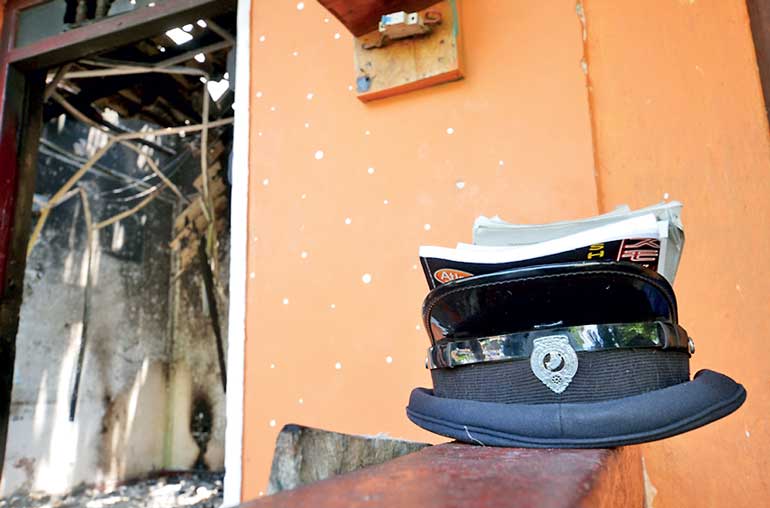Saturday Apr 19, 2025
Saturday Apr 19, 2025
Thursday, 15 March 2018 00:00 - - {{hitsCtrl.values.hits}}
 In the past six years over 300 religious-related incidents of violence have taken place in the country, often in the presence of Sri Lankan Police and forces – Pic by Shehan Gunasekara
In the past six years over 300 religious-related incidents of violence have taken place in the country, often in the presence of Sri Lankan Police and forces – Pic by Shehan Gunasekara
The aim of this article is to explore the communal violence in Sri Lanka and find out the root causes and mechanisms to solve such conflicts in the future.
Communal violence is not a new phenomenon in the country. Throughout history there have been many incidents of communal violence among the Sinhala, Tamil and Muslim ethnic groups. However in the post conflict era, religious violence has become very common between the Sinhala and Muslim ethnic groups.
Over 300 religious-related incidents of violence in six years
It is reported that in the past six years over 300 religious-related incidents of violence took place elsewhere in the country such as Dambulla, Anuradhapura, Maligawatta, Aluthgama, Kooragala, Gintota, Ampara, Digana, Kandy, Puttalam, etc. The above events have killed a number of people and have caused massive losses to the Sri Lankan economy. 
The Sri Lankan Government which is responsible to protect the people regardless of ethnicity, religion, and race seems to not respond in a proper manner to curtail such violence and not implement any measures to prevent such violence.
It is noted that most of the communal violence took place in the presence of Sri Lankan Police and forces. It has brought some suspense to the Muslims about the law and order and has reduced their esteem in the present Government. If such situations continue, the country may easily relapse into a conflict very soon.
Sri Lanka is a multi-religious country where Buddhists (71%), Hindus (13%), Muslims (9%) and Christians (7%) have lived in peace and harmony for over 1,000 years. However, in the post-conflict era (after 2009) religious-related violence between Sinhalese and Muslims has become very common. There have been a number of incidents reported in the past.
Digana clash
The violence that took place in Kandy (Digana) is one of the recent communal clashes between the Sinhala and Muslim ethnic groups. Rioting in Kandy began in Udispattuwa and Teldeniya, later spreading to Digana, Tennekumbura and other areas.
The flames of this violence were ignited when a middle-aged truck driver of Sinhala ethnicity was assaulted by four Muslim youths following a traffic accident. The truck driver died of his injuries four days later.
On 5 March Sinhalese mobs began attacking Muslim properties in the region, resulting in widespread damage to property. The riots, the first large scale Buddhist-Muslim sectarian violence since similar riots in 2014, prompted the Government of Sri Lanka to declare a State of Emergency for a period of 10 days, in addition to the Police curfew already imposed on the district.
Social media networks including WhatsApp, Facebook, Twitter, Telegram and Instagram were blocked in the country in an effort to prevent mobs from organising their attacks and spreading propaganda. Currently, the communal violence in Kandy is fully under control, however there are some minor incidents that have been reported in Puttalam and Aluthgama. It is reported that 25 mosques, 65 shops and over 100 houses were looted and burnt down (partly/fully) by some Sinhala radical youths.
Many root causes for communal violence
There are many root causes for this communal violence in Sri Lanka: Political, economic, social, cultural and religious issues. Regarding the political issue, Cabinet Spokesperson Minister Rajitha Senaratne says that there are two Parliamentarians directly involved in this communal violence, however he did not disclose their names.
Some critiques say that due to the continuous communal violence in Sri Lanka many Muslims have lost their trust and hope both in the SLFP and UNP and remain in a big dilemma about their political stance in the future.
Regarding the economic aspects, the violence in Kandy has cost over a billion rupees to the economy. Further, travel and tourism, stock exchange market and import and export also has been badly affected in the past two weeks.
Regarding the religious issues, there is a lack of understanding among the Sinhalese about Islam, such as the Halal issue, number of mosques, dress code, etc. Although some information has been provided in the past, it has not reached the Sinhala community yet. There is a fear among the Sinhalese about Islam and some extremist groups, similar to how Muslims also fear the Sinhala extreme groups nowadays. Such misunderstandings and mistrust should be eliminated in both communities, otherwise it may lead to further communal violence in the future.
Mechanisms to reduce communal violence
The following mechanisms can be used to reduce communal violence in Sri Lanka:
(1) Religious leaders should play a vital role on this aspect. Religious leaders from both sides should come to one standing and discuss the issues where they have problems and sort it out amongst themselves and then disclose to the public. Frequent discussions and mutual trust is very important between the Sinhala and Muslim communities.
(2) Civil society should play an important role in organising meetings, workshops, forums and open discussions among the academics and respective leaders.
(3) Politicians can play a vital role in this regard, although there are many political diversities among them. For a common purpose they should come to one standing and eliminate the misunderstandings and increase mutual trust and enhance the knowledge for the sake of the country and betterment of people.
(4) Finally the concept of nationalism should be promoted among the people while segregations should be minimised. Although we are Sri Lankan citizens we are not yet ready to refer to ourselves as Sri Lankans, but rather we introduce ourselves as Sinhalese, Muslims and Tamils, etc. Sri Lanka is our country. We all stand for unity, peace, equity, equality, liberty and democracy.
Discover Kapruka, the leading online shopping platform in Sri Lanka, where you can conveniently send Gifts and Flowers to your loved ones for any event including Valentine ’s Day. Explore a wide range of popular Shopping Categories on Kapruka, including Toys, Groceries, Electronics, Birthday Cakes, Fruits, Chocolates, Flower Bouquets, Clothing, Watches, Lingerie, Gift Sets and Jewellery. Also if you’re interested in selling with Kapruka, Partner Central by Kapruka is the best solution to start with. Moreover, through Kapruka Global Shop, you can also enjoy the convenience of purchasing products from renowned platforms like Amazon and eBay and have them delivered to Sri Lanka.
Discover Kapruka, the leading online shopping platform in Sri Lanka, where you can conveniently send Gifts and Flowers to your loved ones for any event including Valentine ’s Day. Explore a wide range of popular Shopping Categories on Kapruka, including Toys, Groceries, Electronics, Birthday Cakes, Fruits, Chocolates, Flower Bouquets, Clothing, Watches, Lingerie, Gift Sets and Jewellery. Also if you’re interested in selling with Kapruka, Partner Central by Kapruka is the best solution to start with. Moreover, through Kapruka Global Shop, you can also enjoy the convenience of purchasing products from renowned platforms like Amazon and eBay and have them delivered to Sri Lanka.